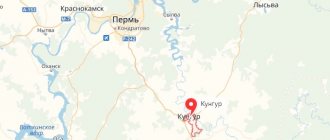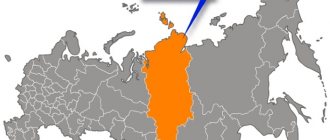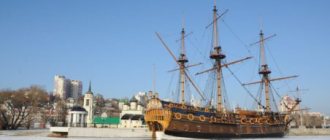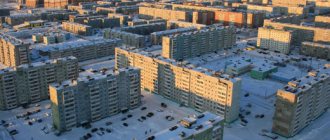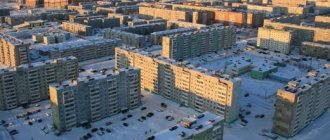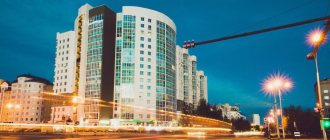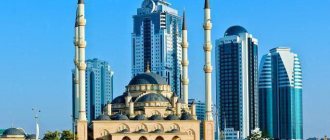Far in the far north of Russia, where a harsh, frosty climate prevails, there is an amazing region called Priobye. This part of the Khanty-Mansiysk Autonomous Okrug is located 250 km from the administrative center of the Tyumen region.
One of the youngest cities of the Ob region is Pyt-Yakh. A region with an area of about 6,500 hectares and a population of approximately 40 thousand people. The small oil region is located on the right side of the Bolshoy Balyk River, which flows throughout the Nefteyugansk and Surgut regions and flows into the Yuganskaya Ob channel.
Where the city of Pyt-Yakh is located can be seen on the geographical map of Russia - this is the place of wells where black gold is methodically extracted. The underground depths are being emptied at every step, right in the city. And not in vain, the symbolism of the region is made in the form of a coat of arms with the image of a bird of the Siberian taiga - a capercaillie, which holds in its paws a silver-black disk, symbolizing an oil source.
City information:
- Founded: 1968
- Population: 40,798 people. (for 2021)
- Telephone code: +7 3463
- Area: 80.4 km²
Today, Pyt Yakh is a rather promising region with developed infrastructure, good highways, and huge industrial enterprises for the extraction and processing of oil and oil and gas products, which are part of the largest industrial companies in Russia.
Pyt-Yakh is a young city, but already has its own attractions
Competitive forestry enterprises in Pyt Yakh supply environmentally friendly wood throughout the country. Thanks to its favorable geographical location, the young city continues to develop and increase its production turnover.
Pyt Yakh on the map of Russian transport infrastructure is considered an important railway junction of regional importance, which provides connections with other autonomous okrugs of the region. Here in the mid-70s a railway was built from Tyumen to Surgut and further to the north. A station was created along this route, which received the ancient Khanty name of the local river Pyt-Yakh.
In addition, in the far northern region, just 90 km from the city center, there is the largest airport in Surgut, providing international and local flights. More distant from the center of Pyt-Yakh, at a distance of 175.4 km, Pokur Airport also plays a significant role in the transportation of goods and passengers for local and long-distance traffic.
A fairly young city was formed and became famous thanks to one of the largest deposits of oil reserves in the West Siberian province of Russia, called the Mamontovskoye field. The history of development dates back to the beginning of 1960, when oil reserves were first discovered in these places.
Etymology
Pyt-Yakh is a Khanty word in the Surgut (Yugan) dialect.
Yah - people, community, community, settlement. Compare: ramid-yakh
(“people of the big channel”) - the Khanty name for the Sockeye salmon;
Okhsar-yakh
(“fox people”) - the Khanty name of the pando genus;
in revolutionary times, the Khanty called the “reds” and “whites” nothing more than vyrd-yakh
(“red people”) and
nayvi-yakh
(“white people”);
the outdated name of the Khanty is “ as-yakh
” (“Ob people”), and their self-name is
kantykh-yakh
.
The word "Yah" can also mean "river". In the Nenets language, “river” sounds like “yakha” (the rivers of Yamal: Mordy-yakha, Yassovey-yakha, Yanzor-yakha
and so on.).
Ramid-yakh
most likely means “big river”, and
Okhsar-yakh
means Fox River.
Khanty clans could be named after the rivers on which they were settled. By the way, the city of Pyt-yakh is named after the river Pyt-yakh
, which flows into the
Bolshoy Balyk
.
Nearby there are the rivers Kut-yakh
and
Sivys-yakh
, on the banks of which there are settlements of the same name. It is quite logical that in the compound names of rivers, the part “yakh” means “river” (similar to the Nenets “yakha”), and not “people, community, settlement.” Usually rivers give names to settlements, and not vice versa.
The word “Pyt” has an ambiguous meaning among the peoples who lived closer to the area: 1) according to the etymological dictionary of I. P. Frolov, “pyt” means “path”; 2) the Khanty meaning of the word “pyt” is “lair”.
From the above word-forming parts, an expedient meaning is derived, in which “Pyt-Yakh” is revealed as a “river path”.
Mass media
Radio stations
- 72.86 – Radio Russia
- 100.1 - Radio "Radio"
- 104.5 – Radio “Ugra”
- 105.8 - Radio Dacha / Ural Media
- 105.3 — Silver rain / Pyt-Yakh-inform
A television
- 12 TVK - Channel One
- 29 TVK – Home / Pyt-Yakh-inform
- 37 TVK - REN-TV / Intelcom
- 39 TVK - Yugra
- 53 TVK - St. Petersburg - Channel Five
- 10 TVK - Russia 1 / RGTRK Yugoria
- 43 TVK - The first multiplex of digital television in Russia
Story
At the beginning of the 20th century, on the right side of the Bolshoy Balyk River, not far from the Pytyakh River, there were yurts of the Ochimkins. They were engaged in squirrel fishing on both banks of the Bolshoi Balyk. In the spring, “fish are hunted in Dolmatkino Pol... In winter, fish are hunted along the Pyt-Yakh River with kots and up to 6 pounds of pike are caught.” By the way, researchers include the Khanty prince Tonya in the Ochimkin family, who is considered a mythical figure and is mentioned in traditions and legends.
The Mamontovskoye oil field was discovered in 1968, and its development began in 1970. This field was considered the second after Samotlor in terms of oil reserves in Western Siberia.
In 1970, the village was a chaotic accumulation of beams and trailers with numerous wooden walkways and bridges across the swamps surrounding Mamontovo. But even under these conditions, oil workers from Tyumen, Kuibyshev, Kazan and Ufa lived and produced oil.
On March 2, 1980, the construction of the villages of Mamontovo and Pyt-Yakh was headed by the oil and gas production enterprise NGDU Mamontovneft, led by the legendary oilman Boris Isaevich Nuriev. The construction itself was headed by the deputy. chief of capital construction of NGDU "Mamontovneft" Oleg Aleksandrovich Vashkevich, who managed to provide the city with both labor and building materials in the conditions of the north and the Soviet system. A large landing of builders arrived from Magnitogorsk. It was Magnitka that formed the backbone of the SU-79, which carried out construction work. In total, about 10 thousand people arrived. The head of Yuganskneftegaz PA, Roman Ivanovich Kuzovatkin, provided considerable assistance.
In March 1982, the villages of Mamontovo, Pyt-Yakh and Yuzhny Balyk were united into one urban-type settlement - Pyt-Yakh.
In 1983, the first library opened in the village of Pyt-Yakh - a branch of the Nefteyugansk centralized library system. The first librarian is Olga Aleksandrovna Grishina.
On August 6, 1990, the village of Pyt-Yakh, Nefteyugansk region, was given the status of a city of district subordination.
Sights of the city of Pyt-Yakh
Pyt-Yakh exists on the map of Russia as an oil city. The history of its development is not very long, but over the years of its existence, its own attractions and cultural objects have appeared here.
This:
The open-air park - historical and ethnographic museum was created by city residents in 2001. On their initiative, the museum was organized in the southern region of the region on a natural, picturesque landscape in the form of an architectural complex of the property of the Yugan Khanty.
The museum object is designed as a summer estate with a small house, two utility rooms and sheds. The house has an oven for baking bread, which was made by local resident A.A. Kakov. On holidays and excursion days, museum workers bake delicious pies and bread in it, which they treat all guests of the estate.
In the farthest corner of the park area there is a sacred place where a mighty cedar grows surrounded by young birch trees. According to local beliefs, the tree has a sacred meaning and served as an invisible connection with the gods of our ancestors.
Today, indigenous residents and guests of the city bring multi-colored ribbons with wishes and decorate the tree.
The local history museum is located in the local library building. There are several halls here, the first holds thematic exhibitions, the second exhibition hall demonstrates the culture of the Khanty peoples and the stages of development of the northern region. The collection of museum exhibits includes about 4,000 historical and cultural values of Ugra.
The Ayaun settlement is recognized as one of the archaeological monuments . It is located in the south-west direction on the left bank of the Bolshoy Balyk River, at a distance of 10 km from Pyt-Yakh. The attraction is a hill with an area of 24 square meters. m. with an elliptical shape and two depressions, around which, judging by the remains, there was a deep ditch with water.
Excavations here have been taking place since 1982, during which two above-ground parts of rectangular dwellings with hearths in the center, household items, dishes with patterns, grinding stones, clay pots and ceramics were discovered. The monument is interpreted as a seasonal, temporary settlement of northern generations.
Memorial complex "Monument of Glory" in honor of the fallen soldiers in the Second World War in the city center. The monument is made in the form of an arrow rising high and an eternal flame. The names of fallen soldiers are engraved on the arrow.
A techno-monument in the form of an authentic combat vehicle with rocket artillery, it was installed in memory and glory of the defenders of the fatherland.
Not far from the station there is a unique creation - a dwelling of the descendants of northern peoples called a chum. They were built carefully and to last for many years. The basis of such a dwelling is poles, and their number depends on the size of the tent. Usually, the poles are installed at the same distance from each other, wrapped with ropes using special technologies, and covered with reindeer skins on top.
The center of such a dwelling was determined where the hearth was supposed to be. According to archaeologists, such huts were familiar to the most ancient hunters of Siberia. Today, a reminder of the life of our ancestors, performed in a more modern interpretation, can be observed in Pyt-Yakh.
There is also the Orthodox Cathedral “Unexpected Joy”, which is located among the forests and is considered one of the most beautiful places in the city.
Economy
The following activities operate in the city:
- Oil producing enterprise - LLC RN-Yuganskneftegaz;
- “Yuzhno-Balyksky Gas Processing Plant” is a branch of JSC SiburTyumenGaz, the main activity is the processing of associated petroleum gas from oil fields of LLC Rosneft-Yuganskneftegaz;
- LLC "Borets Service - Nefteyugansk", the main activity of the enterprise is the provision of other services related to oil and gas production;
- Timber industry company Pyt-Yakhsky branch of OJSC RLC KodaSalymLes;
- Pyt-Yakh branch of the Nefteyugansk branch of RN-Inform LLC;
- Pyt-Yakhsky branch of RN-Avtomatika LLC;
- RITS-1 LLC Mamontovsky KRS;
- Federal chain stores: “Magnit”, “Pyaterochka”, “Monetka”, “Krasnoe Beloe”, “Ermolino Products”, “Svetofor”, digital and household appliance stores “DNS” and “RBT.ru”, communication stores “Euroset” , “Svyaznoy”, “Megafon”, “Tele2”; “Kari”, “Galamart”, “Magnit Cosmetic”, “Sela” and others.
The average salary at the end of 2021 was 66,335 rubles.
Today the city has everything necessary for life: an equestrian club, comfortable housing, a hospital, clinics, cultural centers, shops, schools, kindergartens, gyms, a children's art school, a creativity center, a children's rehabilitation center, a cultural center for the peoples of the North, a branch Nefteyugansk Industrial College, five branches of the central library system. In 2010, the Pyt-Yakh district hospital was opened with the first modern burn center in the Khanty-Mansi Autonomous Okrug.
Notes
Municipal-territorial division
:
Urban districts
: Kogalym Langepas Megion Nefteyugansk Nizhnevartovsk Nyagan Pokachi Pyt-Yakh Rainbow Surgut |
Urai Khanty-Mansiysk Yugorsk Districts
: Beloyarsky Berezovsky Kondinsky Nefteyugansky Nizhnevartovsky Oktyabrsky Sovetsky | | Knowing nothing about each other, we admired our star. She was the best in the sky, Brightest, brightest and clearest... No matter what I did, no matter where I was, I never forgot about her. Everywhere her radiant light warmed my blood with hope. Young, untouched and pure I brought you all my love... The star sang songs to me about you, Day and night it called me into the distance... And on a spring evening, in April, It brought me to your window. I quietly took you by the shoulders, and said, without hiding my smile: “So it was not in vain that I waited for this meeting, my beloved star”...
Mom was completely captivated by dad’s poems... And he wrote them to her a lot and brought them to her work every day along with huge posters drawn by his own hand (dad was a great drawer), which he unrolled right on her desktop, and on which, among of all kinds of painted flowers, it was written in large letters: “Annushka, my little star, I love you!” Naturally, what woman could withstand this for a long time and not give up?.. They never parted again... Using every free minute to spend it together, as if someone could take it away from them. Together they went to the movies, to dances (which they both loved very much), walked in the charming Alytus city park, until one fine day they decided that enough dates were enough and that it was time to look at life a little more seriously. Soon they got married. But only my father’s friend (my mother’s younger brother) Jonas knew about this, since neither my mother’s nor my father’s relatives aroused much enthusiasm for this union... My mother’s parents intended her to marry a rich neighbor-teacher, whom they really liked and, in their opinion, he “suited” his mother perfectly, and in my father’s family at that time there was no time for marriage, since grandfather was sent to prison at that time as an “accomplice of the nobles” (by which they probably tried to “break” the stubbornly resisting father) , and my grandmother ended up in the hospital from a nervous shock and was very sick. Dad was left with his little brother in his arms and now had to run the entire household alone, which was very difficult, since the Seryogins at that time lived in a large two-story house (in which I later lived), with a huge old garden around. And, naturally, such a household required good care... So three long months passed, and my dad and mom, already married, still went on dates, until my mother accidentally went to my dad’s house one day and found a very touching picture there... Dad stood in the kitchen in front of the stove and with an unhappy look “replenished” the hopelessly growing number of pots of semolina porridge, which at that moment he was cooking for his little brother. But for some reason the “evil” porridge became more and more, and poor dad could not understand what was happening... Mom, trying with all her might to hide a smile so as not to offend the unlucky “cook”, rolled up her sleeves and immediately began to bring put all this “stagnant domestic chaos” in order, starting with completely occupied, “porridge-filled” pots, an indignantly sizzling stove... Of course, after such an “emergency”, my mother could no longer calmly observe such “heartbreaking” male helplessness, and decided immediately move to this territory, which was still completely alien and unfamiliar to her... And although it was not very easy for her at that time either - she worked at the post office (to support herself), and in the evenings she went to preparatory classes for passing exams in medicine school.
She, without hesitation, gave all her remaining strength to her exhausted young husband and his family. The house immediately came to life. The kitchen smelled overwhelmingly of delicious Lithuanian zeppelins, which my dad’s little brother adored and, just like dad, who had been sitting on dry food for a long time, he literally gorged himself on them to the “unreasonable” limit. Everything became more or less normal, except for the absence of my grandparents, about whom my poor dad was very worried, and sincerely missed them all this time. But now he already had a young, beautiful wife, who, as best she could, tried in every possible way to brighten up his temporary loss, and looking at my father’s smiling face, it was clear that she succeeded quite well. Dad’s little brother very soon got used to his new aunt and followed her tail, hoping to get something tasty or at least a beautiful “evening fairy tale”, which his mother read to him in great abundance before bed. Days and then weeks passed so calmly in everyday worries. Grandmother, by that time, had already returned from the hospital and, to her great surprise, found her newly-made daughter-in-law at home... And since it was too late to change anything, they simply tried to get to know each other better, avoiding unwanted conflicts (which inevitably arise when any new, too close acquaintance). More precisely, they were simply getting used to each other, trying to honestly avoid any possible “underwater reefs”... I was always sincerely sorry that my mother and grandmother never fell in love with each other... They both were (or rather, my mother still is) wonderful people, and I loved them both very much. But if my grandmother, throughout our entire life together, somehow tried to adapt to my mother, then my mother, on the contrary, at the end of my grandmother’s life, sometimes too openly showed her her irritation, which deeply hurt me, since I was very attached to both of them and very I didn’t like to fall, as they say, “between two fires” or to forcibly take someone’s side. I could never understand what caused this constant “quiet” war between these two wonderful women, but apparently there were some very good reasons for this, or perhaps my poor mother and grandmother were simply truly “incompatible” , as happens quite often with strangers living together. One way or another, it was a great pity, because, in general, it was a very friendly and faithful family, in which everyone stood up for each other and went through every trouble or misfortune together. But let’s go back to those days when all this was just beginning, and when each member of this new family honestly tried to “live together”, without creating any trouble for the others... Grandfather was already at home, but his health, to the great regret of everyone else, days spent in custody, things deteriorated sharply. Apparently, including the difficult days spent in Siberia, all the long ordeals of the Seryogins in unfamiliar cities did not spare the poor, life-torn grandfather’s heart - he began to have recurring micro-infarctions... Mom became very friendly with him and tried as best she could to help him forget everything as soon as possible bad, although she herself had a very, very difficult time. Over the past months, she managed to pass the preparatory and entrance exams for medical school. But, to her great regret, her old dream was not destined to come true for the simple reason that at that time in Lithuania you still had to pay for the institute, and her mother’s family (which had nine children) did not have enough finances for this... the same year, from a severe nervous shock that happened several years ago, her still very young mother died - my grandmother on my mother’s side, whom I also never saw. She fell ill during the war, on the day when she learned that there was a heavy bombing in the pioneer camp, in the seaside town of Palanga, and all the surviving children were taken to an unknown place... And among these children was her son, the most the youngest and favorite of all nine children. A few years later he returned, but, unfortunately, this could no longer help my grandmother. And in the first year of my mother and father’s life together, it slowly faded away... My mother’s father – my grandfather – was left with a large family, of which only one of my mother’s sisters – Domitsela – was married at that time. And grandfather’s “businessman”, unfortunately, was absolutely disastrous... And very soon the woolen factory, which he, with his grandmother’s “light hand”, owned, was put on sale for debts, and grandmother’s parents did not want to help him anymore, since it This was already the third time when grandfather completely lost everything they had donated. My grandmother (my mother’s mother) came from a very rich Lithuanian noble family, the Mitrulevicius, who, even after “dekulakization,” still had a lot of land. Therefore, when my grandmother (against the wishes of her parents) married my grandfather, who had nothing, her parents (in order not to lose face) gave them a large farm and a beautiful, spacious house... which, after some time, grandfather , thanks to his great “commercial” abilities, lost. But since at that time they already had five children, naturally, grandmother’s parents could not stay away and gave them a second farm, but with a smaller and not so beautiful house. And again, to the great regret of the whole family, very soon the second “gift” was gone too... The next and last help from my grandmother’s patient parents was a small woolen factory, which was superbly equipped and, if used correctly, could generate a very good income, allowing the whole grandmother's family can live comfortably. But my grandfather, after all the troubles he had experienced in life, by this time had already dabbled in “strong” drinks, so the almost complete ruin of the family did not have to wait too long... It was precisely this careless “economic management” of my grandfather that put his entire family in a very difficult financial situation when all children had to work and support themselves, no longer thinking about studying in higher schools or institutes. And that is why, having buried her dreams of becoming a doctor one day, my mother, without much choice, went to work at the post office, simply because there was a free position there at that time. So, without any special (good or bad) “adventures”, in simple everyday worries, the life of the young and “old” Seryogin family passed for some time. Almost a year has passed. Mom was pregnant and was about to expect her first child. Dad literally “flyed” with happiness, and told everyone that he would definitely have a son. And he turned out to be right - they really had a boy... But under such terrifying circumstances that even the sickest imagination could not have imagined... Mom was taken to the hospital one Christmas day, literally before the New Year. At home, of course, they were worried, but no one expected any negative consequences, since my mother was a young, strong woman, with a well-developed athlete’s body (she had been actively involved in gymnastics since childhood) and, according to all general concepts, childbirth should have been easy. But someone up there, “high up”, for some unknown reasons, apparently really didn’t want my mother to have a child... And what I will tell you next does not fit into any framework of philanthropy or medical oath and honor. The Remake doctor who was on duty that night, seeing that the mother’s labor had suddenly dangerously “stalled” and that it was getting harder for the mother, decided to call the chief surgeon of the Alytus Hospital, Doctor Ingelevičius... who had to be pulled out that night right from the festive table. Naturally, the doctor turned out to be “not entirely sober” and, having quickly examined my mother, immediately said: “Cut!”, apparently wanting to quickly return to the “table” that had been so hastily abandoned. None of the doctors wanted to contradict him, and my mother was immediately prepared for the operation. And then the most “interesting” thing began, from which, listening to my mother’s story today, my long hair stood on end on my head….
Transport system
Railway transport
In 1988, a modern building of the railway station of the Sverdlovsk Railway was built. Pyt-Yakhsky railway station is the nearest railway station for residents of Nefteyugansk.
Urban transport
The organization of passenger transportation by public transport is carried out by 1 carrier - a municipal unitary passenger motor transport enterprise, the number of bus routes in city traffic is 40 units, including 6 special routes, the daily output of buses is more than 18 units. The fare is 26 rubles. List of routes:
- 1 “Railway station - Mamontovo (10 microdistrict)”;
- 2 “Railway station - Cheryomushki (9th microdistrict)”;
- 3 “Railway Station - District Hospital”;
- 4 “Railway station - GPZ (7th microdistrict)”;
- 5 “GPP (7th microdistrict) - Mamontovo (10th microdistrict)”;
- 6 "Mamontovo - Railway Station - 2a microdistrict";
- 10 “Railway station - SK Zhemchuzhina - Mamontovo (10th microdistrict)”;
- 18 In the morning and evening: “Atlant - Railway Station - Daci (Puchip)”, In the afternoon: “Railway Station - Atlant - Daci (Gidrovets)”. The bus is open for the summer
Population
| ↗ 42 500 | ↘ 42 100 | ↘ 41 813 | ↘ 41 800 | ↘ 41 500 | → 41 500 | ||
| 2008 | 2009 | 2010 | 2011 | 2012 | 2013 | 2014 | 2015 |
| ↗ 41 600 | ↘ 41 397 | ↗ 41 488 | ↗ 41 533 | ↘ 41 125 | ↘ 40 818 | ↗ 41 000 | ↗ 41 005 |
| 2016 | |||||||
| ↘ 40 910 |
As of January 1, 2021, the city ranked 377th out of 1,112 cities in the Russian Federation in terms of population.
Demography
The population size is influenced by natural growth, which compensates for mechanical outflow. Natural population growth amounted to 416 people, or 105.1% of last year’s level (according to the state statistics department). The migration loss amounted to 580 people, or 155.9% of the 2007 level.
| Nationality | Number (persons) | Percentage |
| Russians | 23 140 | 55,78% |
| Ukrainians | 3 850 | 9,28% |
| Tatars | 3 078 | 7,42% |
| Kumyks | 2073 | 5,00% |
| Bashkirs | 1 325 | 3,19% |
| Azerbaijanis | 1 139 | 2,75% |
| Chechens | 701 | 1,69% |
| Chuvash | 575 | 1,39% |
| Lezgins | 549 | 1,32% |
| Moldovans | 474 | 1,14% |
| Belarusians | 322 | 0,78% |
| Nogais | 305 | 0,74% |
| Tajiks | 267 | 0,64% |
| Other | 1 870 | 4,51% |
| Not specified | 1 820 | 4,39% |
| Total | 41 488 | 100,00% |
Culture
The city has 6 secondary schools, 10 kindergartens, and a children's and youth sports school.
There is a television and radio company and a regional newspaper in the city.
The history of music education in Pyt-Yakh begins in 1987, when a children's music school was founded. In 1996, the music school was reorganized and became part of the Children's Art School as a music department. In 2010, the school population was 1,100 students, 110 employees, of which 67 were teachers.


